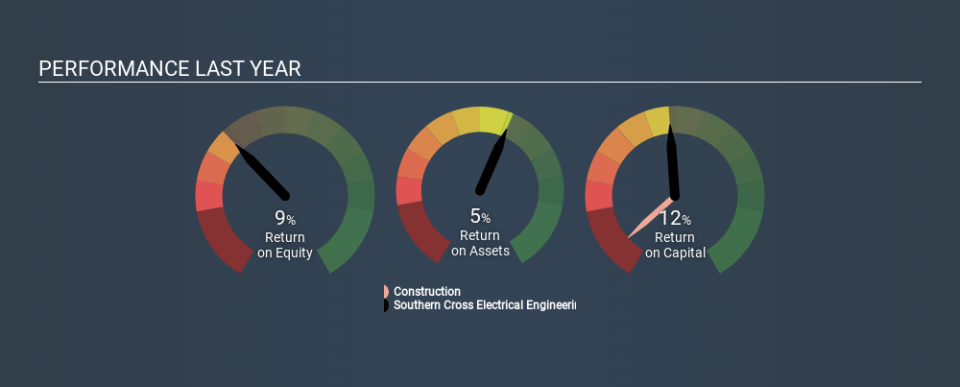Are Southern Cross Electrical Engineering Limited’s (ASX:SXE) Returns On Investment Worth Your While?

Today we'll evaluate Southern Cross Electrical Engineering Limited (ASX:SXE) to determine whether it could have potential as an investment idea. Specifically, we're going to calculate its Return On Capital Employed (ROCE), in the hopes of getting some insight into the business.
First of all, we'll work out how to calculate ROCE. Then we'll compare its ROCE to similar companies. And finally, we'll look at how its current liabilities are impacting its ROCE.
What is Return On Capital Employed (ROCE)?
ROCE measures the 'return' (pre-tax profit) a company generates from capital employed in its business. All else being equal, a better business will have a higher ROCE. Ultimately, it is a useful but imperfect metric. Renowned investment researcher Michael Mauboussin has suggested that a high ROCE can indicate that 'one dollar invested in the company generates value of more than one dollar'.
How Do You Calculate Return On Capital Employed?
Analysts use this formula to calculate return on capital employed:
Return on Capital Employed = Earnings Before Interest and Tax (EBIT) ÷ (Total Assets - Current Liabilities)
Or for Southern Cross Electrical Engineering:
0.12 = AU$19m ÷ (AU$275m - AU$108m) (Based on the trailing twelve months to December 2019.)
Therefore, Southern Cross Electrical Engineering has an ROCE of 12%.
View our latest analysis for Southern Cross Electrical Engineering
Does Southern Cross Electrical Engineering Have A Good ROCE?
ROCE can be useful when making comparisons, such as between similar companies. Using our data, Southern Cross Electrical Engineering's ROCE appears to be around the 12% average of the Construction industry. Independently of how Southern Cross Electrical Engineering compares to its industry, its ROCE in absolute terms appears decent, and the company may be worthy of closer investigation.
Southern Cross Electrical Engineering delivered an ROCE of 12%, which is better than 3 years ago, as was making losses back then. That suggests the business has returned to profitability. You can click on the image below to see (in greater detail) how Southern Cross Electrical Engineering's past growth compares to other companies.
When considering ROCE, bear in mind that it reflects the past and does not necessarily predict the future. Companies in cyclical industries can be difficult to understand using ROCE, as returns typically look high during boom times, and low during busts. This is because ROCE only looks at one year, instead of considering returns across a whole cycle. Since the future is so important for investors, you should check out our free report on analyst forecasts for Southern Cross Electrical Engineering.
What Are Current Liabilities, And How Do They Affect Southern Cross Electrical Engineering's ROCE?
Short term (or current) liabilities, are things like supplier invoices, overdrafts, or tax bills that need to be paid within 12 months. The ROCE equation subtracts current liabilities from capital employed, so a company with a lot of current liabilities appears to have less capital employed, and a higher ROCE than otherwise. To counteract this, we check if a company has high current liabilities, relative to its total assets.
Southern Cross Electrical Engineering has current liabilities of AU$108m and total assets of AU$275m. As a result, its current liabilities are equal to approximately 39% of its total assets. Southern Cross Electrical Engineering has a medium level of current liabilities, which would boost the ROCE.
The Bottom Line On Southern Cross Electrical Engineering's ROCE
Southern Cross Electrical Engineering's ROCE does look good, but the level of current liabilities also contribute to that. Southern Cross Electrical Engineering shapes up well under this analysis, but it is far from the only business delivering excellent numbers . You might also want to check this free collection of companies delivering excellent earnings growth.
If you like to buy stocks alongside management, then you might just love this free list of companies. (Hint: insiders have been buying them).
If you spot an error that warrants correction, please contact the editor at editorial-team@simplywallst.com. This article by Simply Wall St is general in nature. It does not constitute a recommendation to buy or sell any stock, and does not take account of your objectives, or your financial situation. Simply Wall St has no position in the stocks mentioned.
We aim to bring you long-term focused research analysis driven by fundamental data. Note that our analysis may not factor in the latest price-sensitive company announcements or qualitative material. Thank you for reading.

